Thailand |
|
|
|
| Übersicht – Contents: | |
Thailand |
|
|
|
| Übersicht – Contents: | |
Flaggen – Flags: |
|
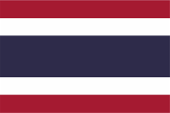 |
National-, Staats und Handelsflagge – national, state and merchant flag, Seitenverhältnis – ratio = 2:3, Quelle/Source, nach/by: Flags of the World   |
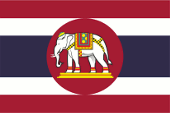 |
Seekriegsflagge – naval war flag, Seitenverhältnis – ratio = 2:3, Quelle/Source, nach/by: Flags of the World  |
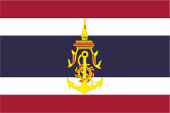 |
Gösch – naval jack, Seitenverhältnis – ratio = 2:3, Quelle/Source, nach/by: Flags of the World |
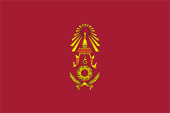 |
Flagge des Heeres – flag of the Army, Seitenverhältnis – ratio = 2:3, Quelle/Source, nach/by: Flags of the World |
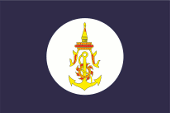 |
Flagge des Marine – flag of the Navy, Seitenverhältnis – ratio = 2:3, Quelle/Source, nach/by: Flags of the World |
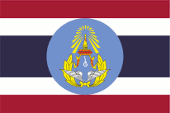 |
Flagge der Luftwaffe – flag of the Air Force, Seitenverhältnis – ratio = 2:3, Quelle/Source, nach/by: Flags of the World |
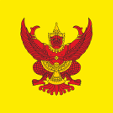 |
Standarte des Königs – standard of the King, Seitenverhältnis – ratio = 1:1, Quelle/Source, nach/by: Flags of the World |
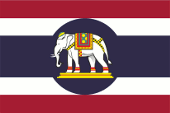 |
Flagge für Botschafter – flag for Ambassadors, Seitenverhältnis – ratio = 2:3, Quelle/Source, nach/by: Flags of the World |
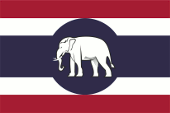 |
Flagge für Konsuln – flag for Consuls, Seitenverhältnis – ratio = 2:3, Quelle/Source, nach/by: Flags of the World |
historische Flaggen – historical Flags: |
|
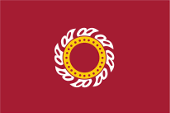 |
1782–1817, National- und Staatsflagge – national and state flag, Seitenverhältnis – ratio = 2:3, Quelle/Source, nach/by: Flags of the World, Die Welt der Flaggen |
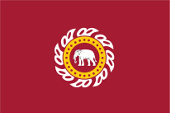 |
1817–1855, National- und Staatsflagge – national and state flag, Seitenverhältnis – ratio = 2:3, Quelle/Source, nach/by: Flags of the World, Die Welt der Flaggen |
 |
1855–1916, National- und Staatsflagge – national and state flag, Seitenverhältnis – ratio = 2:3, Quelle/Source, nach/by: Flags of the World, Die Welt der Flaggen |
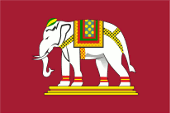 |
1891–1916, Kriegsflagge – war flag, Seitenverhältnis – ratio = 2:3, Quelle/Source, nach/by: Flags of the World, Die Welt der Flaggen |
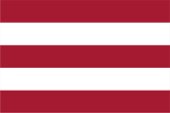 |
1916–1917, National- und Staatsflagge – national and state flag, Seitenverhältnis – ratio = 2:3, Quelle/Source, nach/by: Flags of the World, Flaggen und Wappen der Welt |
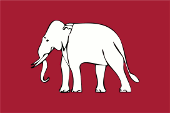 |
1942–1945, National-, Staats und Kriegsflagge – national state and war flag, Seitenverhältnis – ratio = 2:3, Quelle/Source, nach/by: Flags of the World |
|
Die heutige Flagge
Thailands wurde am 28.09.1917 eingeführt. Sie zeigt fünf waagerechte
Streifen in Rot, Weiß, Blau, Weiß und Rot im Verhältnis 1:1:2:1:1. Die
Farben der Flagge wurden in einer Bekanntmachung des Büros des
Premierministers vom 30.09.2017 anlässlich des 100. Jahrestages ihrer
Einführung vereinheitlicht. Die darin enthaltenen Farbvorgaben enthalten
auch Werte aus dem RGB-Farbraum, so für Rot 165-25-49 und für Blau 45-42-74,
was in etwa folgenden Pantone-Farbtönen entsprechen würde: Rot = Pantone 201
c, Blau = Pantone 5255 c. Die Flagge wird "Tairong" oder "Trairanga"
(Trikolore) genannt. Sie zeigte ursprünglich nur die Farben Rot und Weiß.
Blau wurde im Jahre 1917 ergänzt, angeblich um darauf hinzuweisen, dass
Thailand im Ersten Weltkrieg ein Verbündeter der Entente war. Viele Flaggen
der Entente-Staaten (Frankreich, Großbritannien, USA) zeigten ebenfalls die
Farben Rot, Weiß und Blau. Zur Deutung der Farben gibt es folgende Theorien: • Rot und Weiß symbolisieren die Blutopfer und die Reinheit des Volkes, während Blau mit dem Königshaus in Verbindung gebracht wird • Rot steht für die Nation, Weiß für die Religion und Blau für die Monarchie • Die Farbkombination Blau, Weiß und Rot als Nationalfarben geht auf die Zeit des Ersten Weltkrieges zurück, als das Land ein Verbündeter der Entente gewesen ist, und dies mit der Verwednung dieser Farben zum Ausdruck gedracht werden sollte, da die wichtigsten Länder der Entente diese Farben ebenfalls in ihren Flaggen hatten. Das Emblem des Herrscherhauses der Chakri-Dynastie ist das Tschakra (buddhistisches Rad der Lehre, der Name der Dynastie stammt davon ab), das in Siam die Gestalt einer umlaufenden Scheibe mit flammenartigen Klingen am Rand hatte. Die erste Flagge Siams aus dem Jahr 1782 war rot mit einem weißen Tschakra. Im Jahre 1817 wurde dem Zentrum des Rades ein weißer Elefant hinzugefügt, und ab 1855 wurde nur noch der weiße Elefant benutzt. Der weiße Elefant ist ein sehr altes siamesisches Symbol, und ein dreiköpfiger Elefant war in alten Zeiten das Nationalemblem (auch im benachbarten Laos). Für die Kriegsflagge wurde im Jahre 1891 das Bild eines Elefanten in Zaumzeug und Rüstung eingeführt. Im Jahre 1916 wurde die Flagge sehr stark vereinfacht: Sie zeigte nur noch ein rotes Tuch mit zwei waagerechten weißen Streifen. Angeblich sollte diese Form der Flagge das versehentliche umgekehrte Hissen verhindern. Nachdem sich Siam im Zweiten Weltkrieg an die Seite Japans stellte, wurde die Flagge mit dem weißen Elefanten wiederbelebt. Die bis dato gültige blau-weiß-rote Flagge wäre farblich den Alliierten zuzuordnen gewesen, und so wurden Verwechslungen ausgeschlossen, gerade auch in der Kennzeichnung der Flugzeuge der Luftwaffe. Umgekehrt verschwand aus dem US-Luftwaffen-Stern der zentrale rote Punkt, genau so wie der zentrale rote Punkt aus der britischen Kokarde (nur auf dem pazifischen Kriegsschauplatz). |
The current flag of
Thailand was introduced on 28th of September in 1917. It shows five
horizontal stripes in red, white, blue, white and red in a ratio of
1:1:2:1:1. The colors of the flag were unified in a proclamation from the
Prime Minister's Office dated on 30th of September in 2017 to mark the 100th
anniversary of the adoption of the today's flag. The colour specifications contain therein also values from the RGB color space, such as 165-25-49 for red and 45-42-74 for blue, which would roughly correspond to the following Pantone colors: Red = Pantone 201 c, Blue = Pantone 5255 c. The flag is called "Tairong" or "Trairanga" (tricolor). It originally only showed the colours red and white. Blue was added in 1917, ostensibly to indicate that Thailand was an ally of the Entente in World War I. Many flags of the Entente states (France, Great Britain, USA) also showed the colours red, white and blue. There are the following theories about the interpretation of colours: • Red and white symbolize the blood sacrifices and purity of the people, while blue is associated with royalty • Red represents the nation, white represents religion and blue represents the monarchy • The colour combination of blue, white and red as national colors dates back to the time of the First World War, when the country was an ally of the Entente, and this was intended to be expressed by using these colors, as the most important countries of the Entente also used these colours in their flags. The emblem of the ruling house of the Chakri dynasty is the chakra (Buddhist wheel of teaching, the name of the dynasty comes from it), which in Siam had the shape of a circumferential disk with flame-like blades on the edge. The first flag of Siam, from 1782, was red with a white chakra. In 1817 a white elephant was added to the center of the wheel, and from 1855 only the white elephant was used. The white elephant is a very ancient Siamese symbol, and a three-headed elephant was the national emblem in ancient times (including in neighboring Laos). The image of an elephant in bridle and armor was introduced for the war flag in 1891. In 1916 the flag was greatly simplified: It only showed a red bunting with two horizontal white stripes. Supposedly this shape of the flag was intended to prevent accidental flying upside down. After Siam sided with Japan in World War II, the white elephant flag was revived. The blue, white and red flag that had been in effect until then would have been assigned to the Allies in terms of colour, and so confusion was ruled out, especially in the markings of the air force. Conversely, the central red dot disappeared from the US Air Force star, just as the central red dot disappeared from the British cockade (only in the Pacific theater). |
| Quelle/Source: Flags of the World, Wikipedia (EN), Die Welt der Flaggen, Flaggen Wappen Hymnen, Flaggen und Wappen der Welt, Corel Draw 4, Flaggen Enzyklopädie, Volker Preuß | |
Wappen – Coat of Arms: |
|
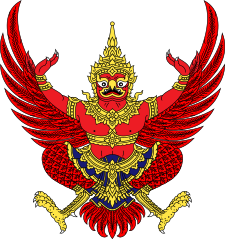 |
Wappen von Thailand – Coat of arms of Thailand, Quelle/Source, nach/by: Sodacan, Public domain, via Wikimedia Commons |
| Das Staatswappen von Thailand wurde von König Rama VI. bei seiner Thronbesteigung 1910 eingeführt. Es zeigt einen stilisierten Garuda, den mythischen Reitvogel Vishnus, des Gottes der Tapferkeit. Der Garuda gilt als Beschützer vor allen Giften und anderen schädlichen Einflüssen. Die königliche Standarte zeigt den Garuda auf gelbem Grund, und wurde ebenfalls 1910 eingeführt. | The coat
of arms of Thailand was introduced by King Rama VI. on the occasion of his
accession to the throne in 1910. It shows a stylized Garuda – the mythical
ride-bird of Vishnu – the god of bravery. The Garuda is the protector from all poisons and other damaging influxes. The royal standard shows the Garuda on yellow ground and was as well introduced in 1910. |
| Quelle/Source: Flaggen Wappen Hymnen | |
Flugzeugkokarde – aircraft roundel: |
|
 |
Flugzeugkokarde – aircraft roundel Quelle/Source, nach/by: Flags of the World |
 |
Kennzeichen für Militärflugzeuge – aircraft emblem (fin flash) Quelle/Source, nach/by: Flags of the World |
 |
1941–1945, Flugzeugkokarde – aircraft roundel Quelle/Source, nach/by: Flags of the World |
 |
1941–1945, Kennzeichen für Militärflugzeuge – aircraft emblem (fin flash) Quelle/Source, nach/by: Flags of the World |
Landkarte – Map: |
Lage – Position: |
Landkarte des Landes – Map of the Country: |
|
|
| Zahlen und Fakten – Numbers and Facts: | |
|
|
|
|
|
|
|
|
|
|
|
|
|
|
|
|
|
|
|
1.–13. Jahrhundert · Einwanderung der Siamesen aus Südchina 12. Jahrhundert · des Gebiet des heutigen Tahiland kommt an das Khmer-Königreich von Angkor 1238 · Gründung des Siamesischen Königreichs Sukhothai (Sukhodaja) unter König Intarachit 1350 · Verlegung der Hauptstadt von Sukhothai nach Ayuthia (auch Ayutthaya, 40 km nördlich Bangkok) 1555 · Eroberung des Siamesischen Reiches von Ayuthia durch Burma 1579 · Nationalaufstand unter Phra Naret 1593 · Ayuthia ist wieder unabhängig 16. Jahrhundert · Europäer landen an der Küste, Errichtung von Handelsstationen 17./18. Jahrhundert · Bürgerkriege, Wirren, Tributpflicht an China 1767 · Burma erobert Siam, Zerstörung der Stadt Ayuthia 1768 · Nationalaufstand unter Phaja Tack Sin, Vertreibung der Burmesen, Phaja Tack Sin lässt sich zum König ausrufen und verlegt die Hauptstadt nach Bangkok 1782 · General Phaja Chakri ermordet Phaja Tack Sin und ernennt sich selbst zum König (Rama I.), Gründung der bis heute regierenden Chakri-Dynastie (ab 1916 Rama-Dynastie genannt) 18./19. Jahrhundert · Ausdehnung Siams durch Eroberung von (Laos) und Siem-Reap (Kambodscha) 1855–1857 · Verträge mit Großbritannien, Frankreich und den USA 1893–1907 · Siam muss Luang Prabang und Siem-Reap und Champasak an Frankreich abtreten 1896 · Großbritannien und Frankreich sichern sich Einflussgebiete im Westen, Süden und Osten, Zentralsiam bleibt jedoch frei und unabhängig 1909 · Siam verzichtet zugunsten Großbritanniens auf die Oberhoheit über Perlis, Kedah, Kelantan und Terengganu 1914–1918 Erster Weltkrieg · Siam nimmt auf der Seite der Entente teil 1932 · neue Verfassung, Ende der absoluten Monarchie 1938 · Putsch durch Marschall Pibul Songgram 23.06.1939 · Proklamation des Königreichs Thailand 1939–1945 Zweiter Weltkrieg · März 1941: Thailand okkupiert Sayaboury, Siem-Reap und Champasak · Dezember 1941: Vertrag mit Japan · Januar 1942: Kriegserklärung an Großbritannien und die USA, Einmarsch japanischer Truppen · 1943: Annexion von Teilen Shanlands (Burma) und Annexion von Perlis, Kedah, Kelantan and Terengganu · 1944: Sturz der Regierung Songgram · 15.08.1945: Abzug der japanischen Truppen · September 1945: Thailand tritt Shanland, Perlis, Terengganu, Kedah und Kelantan wieder ab 07.12.1946 · Thailand tritt Sayaboury, Siem-Reap und Champasak wieder an Frankreich ab 1948 · Putsch durch Marschall Pibul Songgram (bis 1957) 1954 · Beitritt zur SEATO 1958 · Putsch durch Marschall Sarit Thanarat 1964 · Tod von Marschall Pibul Songgram seit 1968 · häufige Putsche und Machtübernahmen, Unruhen und Aufstände 2011 · Grenzkonflikt und bewaffnete Auseinandersetzungen mit Kambodscha um den Tempel Prasat Preah Vihear |
|
1st–13th century · immigration of the Siamese from southern China 12th century · the area of the today’s Tahiland comes to the Khmer Kingdom of Angkor 1238 · foundation of the Siamese Kingdom of Sukhothai (Sukhodaja) under King Intarachit 1350 · transfer of the capital from Sukhothai to Ayuthia (also Ayutthaya, 25 miles northern Bangkok) 1555 · conquest of the Siamese Empire of Ayuthia by Burma 1579 · national revolt under Phra Naret 1593 · Ayuthia is independent again 16th century · Europeans debark at the coast, establishment of trading stations 17th/18th century · civil wars, confusions, tributary of China 1767 · Burma conquers Siam, destruction of Ayuthia town 1768 · national revolt under Phaja Tack Sin, expulsion of the Burmese, Phaja Tack Sin proclaimes itself to the king and transfers the capital to Bangkok 1782 · General Phaja Chakri murders Phaja Tack Sin and nominates itself to the king (Rama I.), establishment of the until today ruling Chakri dynasty (since 1916 called Rama dynasty) 18./19. century · expansion of Siam by conquest of Luang Prabang and Champasak (Laos) und Siem-Reap (Cambodia) 1855–1857 · treaties with Great Britain, France and USA 1893–1907 · Siam has to cede Luang Prabang, Siem-Reap and Champasak to France 1896 · Great Britain and France belay zones of influence in the west, south and east, central Siam remains free and independent 1909 · Siam renounces for the benefit of Great Britain for the supremacy over Perlis, Kedah, Kelantan and Terengganu 1914–1918 First World War · Siam participates on the side of the Entente 1932 · new constitution, end of the absolute monarchy 1938 · coup d’état by Marshal Pibul Songgram 23.06.1939 · proclamation of the Kingdom of Thailand 1939–1945 Second World War · March 1941: Thailand occupys Sayaboury, Siem-Reap and Champasak · December 1941: treaty with Japan · January 1942: declaration of war to Great Britain and USA, marching in of Japanese troops · 1943: annexation of parts of Shanland (Burma) and annexation of Perlis, Kedah, Kelantan and Terengganu · 1944: overthrow of the Songgram government · 15th of August 1945: withdrawal of the Japanese troops · September 1945: Thailand cedes Shanland, Perlis, Terengganu, Kedah and Kelantan 7th of December 1946 · Thailand cedes Sayaboury, Siem-Reap and Champasak back to France 1948 · coup d’état by Marshal Pibul Songgram (to 1957) 1954 · Thailand joins the SEATO 1958 · coup d’état by Marshal Sarit Thanarat 1964 · death of Marshal Pibul Songgram since 1968 · frequently coups d’état and comings into power, agitations and riotings 2011 · border conflict and armed clashes with Cambodia over the Prasat Preah Vihear temple |
| Quelle/Source: Atlas zur Geschichte, Wikipedia (DE), Discovery '97, Weltgeschichte |
| Ursprünglich hieß das Land nach seiner Hauptstadt: "Königreich Sukhothai" oder "Königreich Ayuthia", aber im 14. Jahrhundert auch schon "Muang Thai", das "Land der Freien". Nach der Verlegung der Hauptstadt nach Bangkok setzte sich allmählich der Name "Siam" durch. Dieser Name leitete sich vom Volk der Siamesen ab. Ab 1856 war er offiziell. Da Siam eine koloniale Vereinnahmung erfolgreich verhindern konnte, besann man sich 1939 auf den alten Namen "Muang Thai" und Siam wurde wieder das "Land der Freien", international "Thailand" genannt. |
The country was
originally called "Kingdom of Sukhothai" or "Kingdom of Ayuthia" after its
capital, but in the 14th century it was also called "Muang Thai", the "Land
of the Free". After the capital was moved to Bangkok, the name "Siam"
gradually became established. This name was derived from the Siamese people.
It was official from 1856. Since Siam was able to successfully prevent
colonial appropriation, the old name "Muang Thai" was returned to in 1939
and Siam was again called the "Land of the Free", internationally known as
"Thailand". |
| Quelle/Source: Handbuch der geographischen Namen, Die Völker der Erde | |